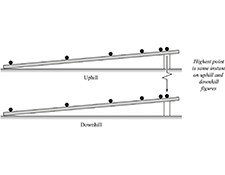
Acceleration in one-dimension
Variant i Conservation laws first Other Variants Dynamics first, Interactive tutorial lecture
This tutorial is intended to help students interpret and apply operational definitions of change in velocity and acceleration while getting practice with vector addition and subtraction.
Topics Mechanics / Kinematics: graphs, idealizations, operational definitions, rates of change, representations, vectors, acceleration, acceleration vs. velocity, change in velocity, kinematics, object on ramp, slopes of graphs, and vector addition & subtraction
Materials
Materials by the UW team
- Instructor Guide


- TA Guide



- Pretest



- Pretest for LMS



- Exam Questions



- Equipment List

Tutorial details
In this tutorial, students are given practice in vector addition and subtraction and guidance in applying the operational definition of acceleration to specific intervals of a ball moving up and down a ramp. Section I focuses on when the ball is moving up the ramp with decreasing speed; Section II focuses on when the ball is moving down the ramp with increasing speed; and Section III focuses on the interval surrounding the turnaround of the ball.
Section I: Motion with decreasing speed.
Aims: Be able to draw velocity vectors with correct directions and relative magnitudes for several instances of time, as well as draw correct change-in-velocity and average acceleration vectors corresponding to consecutive instances. By the end of this section, students should be able to state the direction of acceleration for a ball rolling up a track and slowing down, and give the correct relationship between the directions of velocity and acceleration vectors in this case.
Expected Challenges: Students likely have not yet formed strong reasoning around the direction of acceleration, and may be likely to assume it is in the same direction as the motion. They may also expect the magnitude of the acceleration to mirror the magnitude of the velocity.
Suggestions: Take the time to connect the direction of change-in-velocity to the direction of the acceleration; the later sections build and extend this idea. Helping students form meaning around the physical meaning of acceleration now will help then be able to work through the later sections.
Section II: Motion with increasing speed
Aims: In Section II, the ball is rolling down the ramp and speeding up. The choice to have this context second is intentional; students may be likely to get the right answer for the wrong reasons (acceleration in the direction of motion, rather than in the direction of the change-in-velocity vector). The aim here is to help students make sure they get the right answer for the direction of acceleration using change-in-velocity reasoning.
Expected Challenges: Students may still have a mindset that the acceleration is in the direction of motion. Research has shown this is a challenging misconception to overcome.
Suggestions: Emphasize the relationship between the change in velocity vectors and the acceleration vectors they draw. Probing questions that inquire about this relationship, and offer a contrast to the direction of motion, may help students identify the meaning of the quantities more clearly.
Section III: Motion that includes a change in direction
Aims: Be able to draw velocity vectors with correct directions and relative magnitudes for two instances of time and in two cases: (a) one instant before the turnaround and one instant after, and (b) two instances with one corresponding to the turnaround. As in the previous two sections, students should be able to draw correct change-in-velocity and average acceleration vectors for both cases (a) and (b), state the direction of acceleration near the turnaround, and explain why said direction is independent of the two instances used.
Expected Challenges: Students may not yet have well-developed resources around direction and sign, especially related to drawing the vector addition in part C.
Suggestions: The wording in part C is intentional; many students find it easier to think about what they need to add to the initial vector to arrive at the final vector than trying to diagrammatically subtract the initial from the final. Providing an example of what you expect using points along the ramp before the turnaround may be helpful here; ask what changes when one of the vectors is in the other direction.
For instruction tips, login or register as a verified educator to see the Instructor Guide.
Prerequisites
This tutorial requires minimal background knowledge from the students. It is assumed that vectors have been introduced in class and that velocity and acceleration have been defined. It is also expected, but not required, that students have observed that an object on an incline has a constant acceleration.
Coming Soon! We hope to release the discussion section on each tutorial soon.

